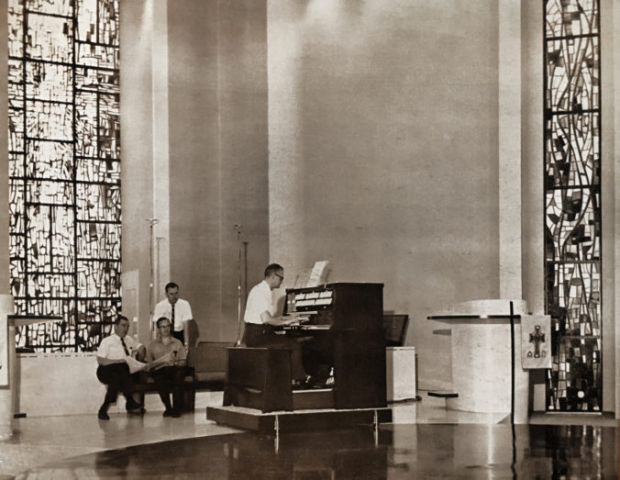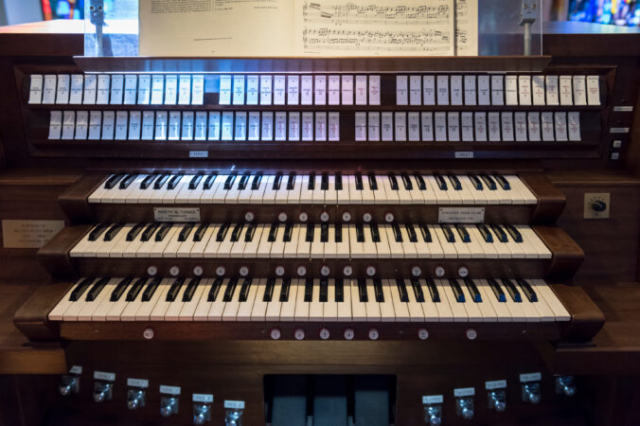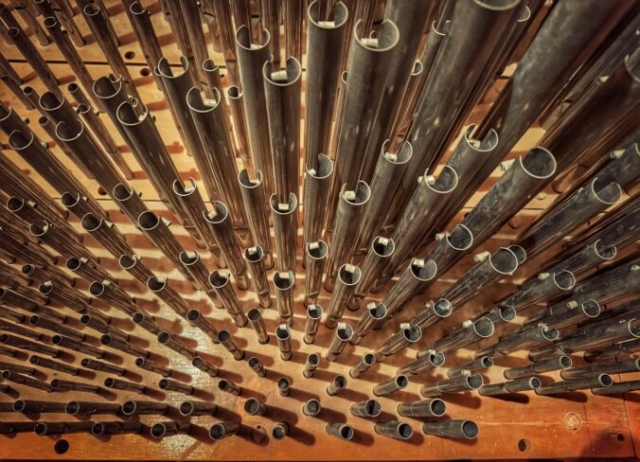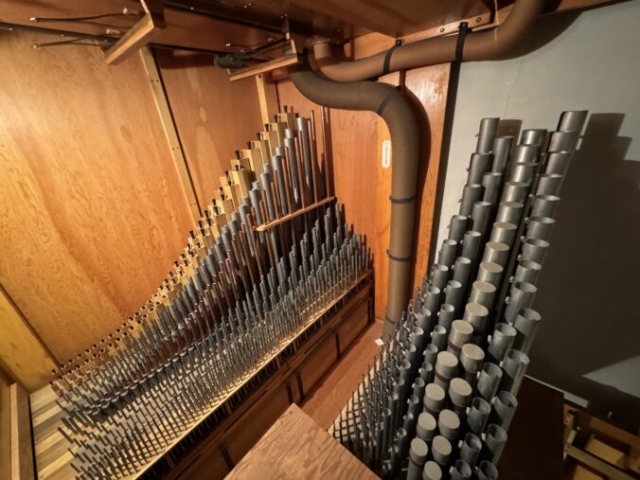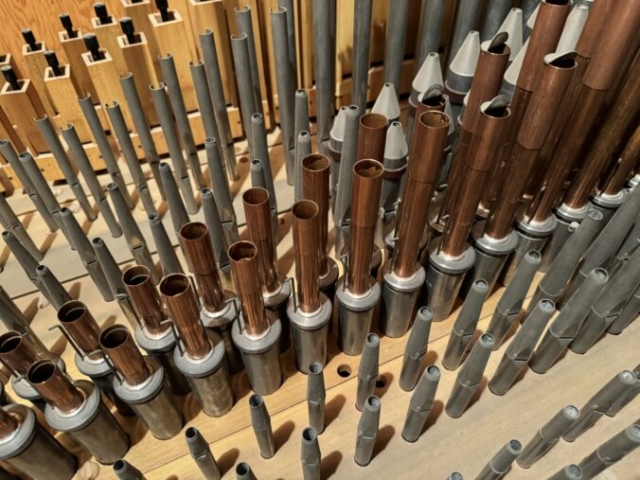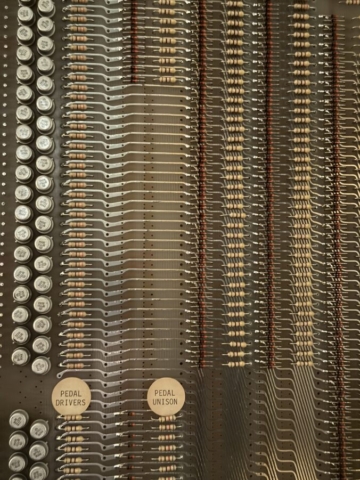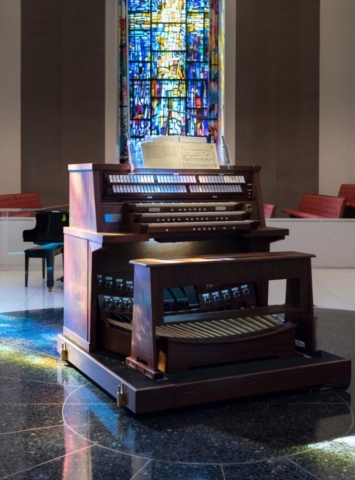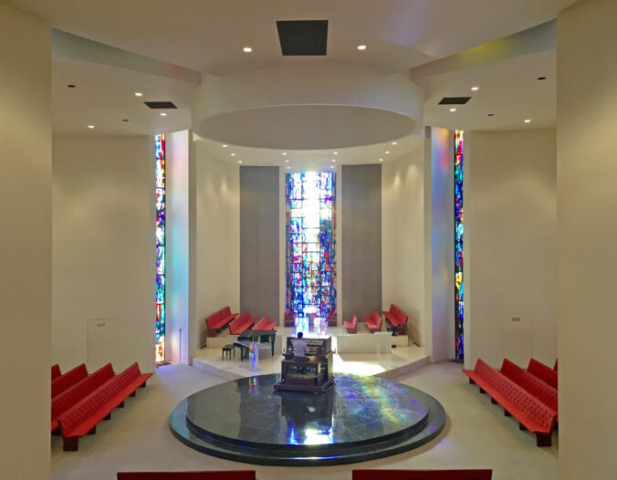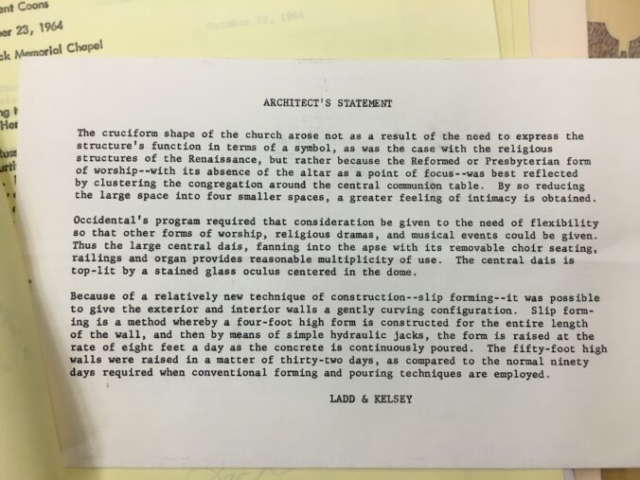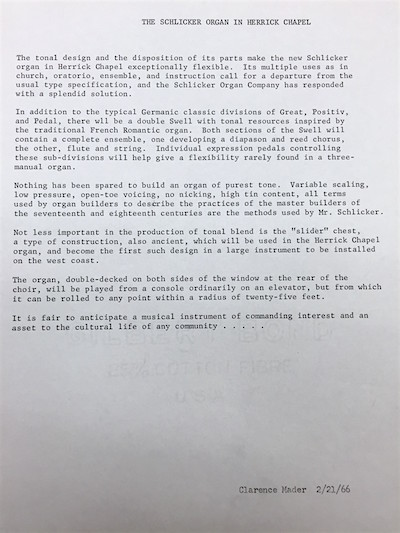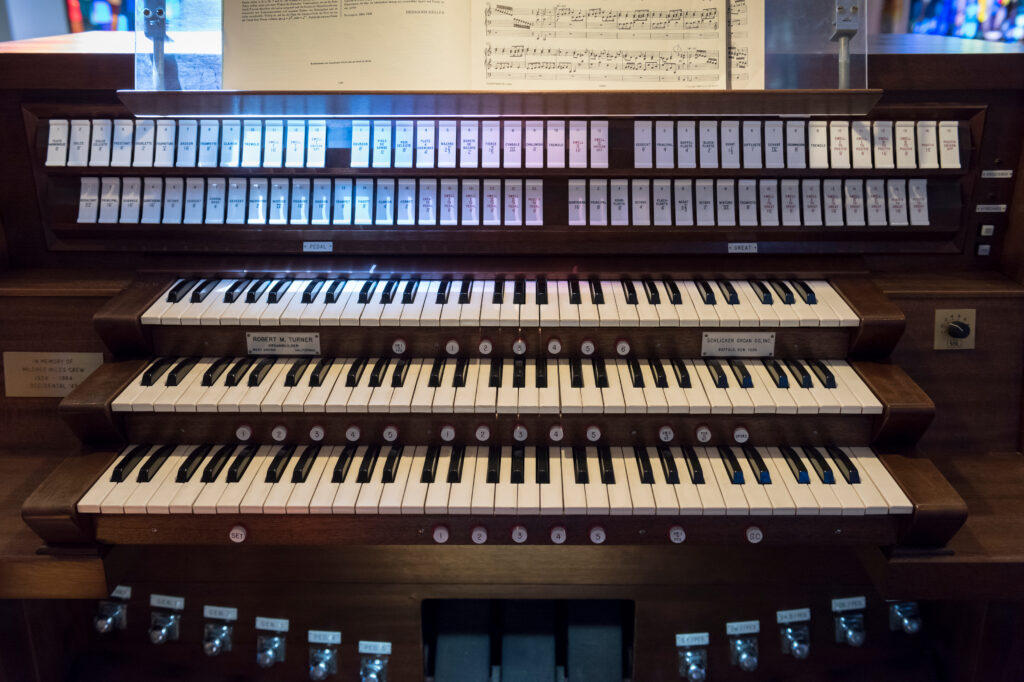
Mildred Miles Crew Memorial Organ
Margaret Brown Herrick Memorial Chapel
Schlicker Organ Co. (1966)
III/P, 51 stops, 59 ranks
Check out the Herrick Chapel Virtual Tour.
1. History
2. Stoplist
3. Photographs
4. Recordings
5. Documents
6. Concerts
1. History
The following is adapted from a program note I wrote for the organ’s 50th Anniversary Recital, performed by Nathan Laube on October 10, 2016.
When the Mildred Miles Crew organ was installed in Herrick Chapel in early 1966, the Occidental College campus was already home to four pipe organs: a large 4-manual E.M. Skinner organ in the campus’s main auditorium, Thorne Hall, along with three 2-manual organs located in Johnson Hall’s Alumni Chapel (now Choi Auditorium), the Music Chapel (now Bird Studio), and Booth Hall’s Choral Rehearsal Room. At the time, Occidental’s Music Department possessed an active organ program, and the instruments were regularly used for performances, lessons, and practice.
Compared with the campus’s existing organs, the organ in Herrick Chapel featured a strikingly different approach to tonal design, exemplifying the ideas of its designers, as well as reflecting a dramatic pendulum swing in the history of modern organ building. While large organs built earlier in the 20th century had frequently taken their tonal cues from the rich sounds of the Romantic orchestra, by the 1950s organists and organ builders were becoming increasingly interested in the music of the 17th and 18th centuries—particularly the polyphonic compositions of Bach and his contemporaries—and they desired instruments that could provide the tonal clarity and crisp articulation that they felt this repertoire required.
In a letter dated January 19, 1960, Clarence Mader, then Occidental’s College Organist and Instructor of Organ, wrote to President Arthur G. Coons to express his dissatisfaction with the condition of the school’s existing organs:
A great resurgence of classical organ design is sweeping over Europe and America. This is bringing renewed enthusiasm for the “king of instruments,” and unprecedented numbers of serious organ students. The day when the organ was looked upon as a third-rate substitute for the orchestra is ended; now the organ is regarded as an instrument in its own right, and is judged in the light of its fitness to interpret the organ classics. Too long I’ve had to tell the students how the music should sound, because our organs cannot give a faithful representation of the composers’ designs. I have come to the conclusion that it is about as easy to teach Bach on a Romantic organ as Chopin on a harpsichord. (Letter in the Occidental College Archives)
Later in the same letter, Mader goes on to propose a major renovation of the Skinner organ in Thorne Hall with the aim of making it more compatible with the Baroque repertoire he was interested in performing and teaching. “The plan,” he writes, “would require a lot of new pipe-work, and the repositioning of the parts of the organ.” With the benefit of historical hindsight, we can be thankful that Mader’s proposal was not approved and that the Skinner’s pipes remained untouched. Instead, he was able to channel his ideas toward the commissioning of a completely new organ to be installed in the campus chapel that was to be built following a generous gift from John Pierce Herrick.
* * *
Herman Schlicker was born in 1902 in Hohentrüdingen, a small Bavarian village about 50 miles south of Nuremberg. After apprenticing with Steinmeyer and working for other European firms, he emigrated to America in 1925 where he found work with the Wurlitzer and Tellers firms before starting his own company in 1932. Clarence Mader’s first introduction to Schlicker’s work came at the 1956 American Guild of Organists convention in New York City. In a concert held at Hunter College, E. Power Biggs performed on a portable 2-manual, 13-rank organ that Schlicker had built for him three years earlier. This instrument, known as the “Cambridge Portativ,” served as Biggs’ residence organ, but could also be packed into a trailer for performance in concert venues. (This same instrument was temporarily installed in Herrick Chapel from 1964-1965 while the college awaited the arrival of the permanent organ.)
Mader must have liked what he heard in New York; following the convention he traveled to Buffalo to tour the Schlicker factory and soon after placed an order with the firm for a 3-manual instrument to be installed in the Westminster Chapel of Immanuel Presbyterian, the grand church on Wilshire Boulevard where Mader served as organist and music director. When it came time to order the organ for Herrick Chapel, Mader worked with Herman Schlicker to create an innovative tonal design. In 1966 Mader wrote a brief description of his conception for the organ:
In addition to the typical Germanic classic divisions of Great, Positiv, and Pedal, there will be a double Swell with tonal resources inspired by the traditional French Romantic organ. Both sections of the Swell will contain a complete ensemble, one developing a diapason and reed chorus, the other flute and string. … Nothing has been spared to build an organ of purest tone. Variable scaling, low pressure, open-toe voicing, no nicking, high tin content, all terms used by organ builders to describe the practices of the master builders of the seventeenth and eighteenth centuries are the methods used by Mr. Schlicker. Not less important in the production of tonal blend is the slider chest, a type of construction, also ancient, which will be used in the Herrick Chapel organ and become the first such design in a large instrument to be installed on the west coast. … It is fair to anticipate a musical instrument of commanding interest and an asset to the cultural life of any community. (See Documents section below.)
On April 24, 1966, the Crew Organ was inaugurated in a recital given by the eminent organist David Craighead, a former Occidental organ professor who had left the college in 1955 to lead the organ program at the Eastman School of Music. The following month Mader performed his own recital on the organ featuring an all-Bach program.
The organ is dedicated to the memory of Mildred Miles Crew ‘45 (1924-1964). To mark its 50th anniversary, the organ is underwent a significant restoration under the direction of Manuel Rosales of Rosales Organ Builders, in collaboration with Kevin Cartwright of the Cartwright Pipe Organ Company. This restoration was supported by the Crew Organ Fund, an endowment which was generously given to the college when the organ was first installed.
2. Stoplist
Herrick Organ Stoplist (PDF version)

3. Photographs
4. Recordings
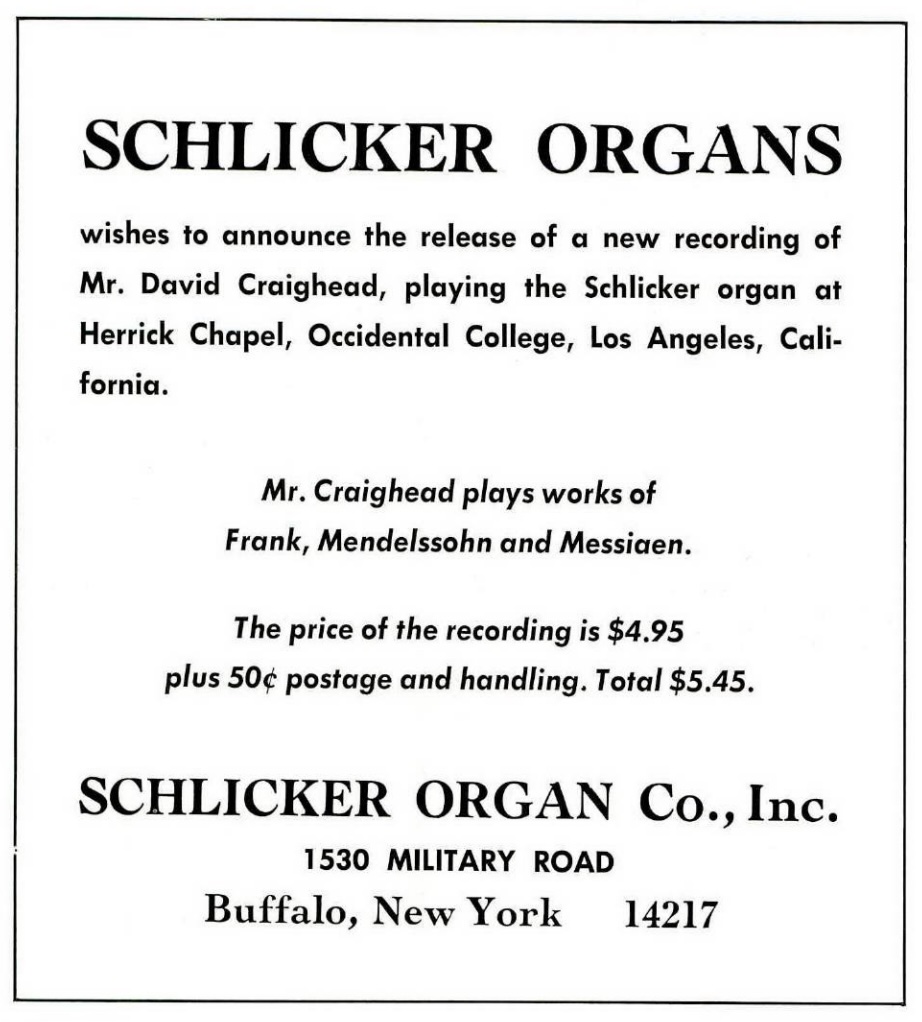
Note: For the recording of Clarence Mader’s Bell Serenade, digital chimes by the Walker Technical Company were temporarily installed on the organ.
5. Archival Documents
An article about the restoration of the Mildred Miles Crew Organ appeared in the Spring 2017 issue of Occidental (the Occidental College alumni magazine). Click the image above to download the PDF.
6. Concerts
Below is a list of concerts that featured the Crew Memorial Organ. Where available, programs for are linked from the performer name.
| Date | Performer(s) | Notes |
|---|---|---|
| October 7, 2024 | Kimberly Marshall | "Cycles in Time: A program exploring over 500 years of music written for the organ." Co-sponsored with the Los Angeles AGO. |
| January 8, 2024 | Masterclass with Christian Schmitt | |
| October 15, 2022 | Masterclass with Tyrone Whiting | Sponsored by the Los Angeles AGO |
| September 23, 2022 | Adán Fernández | Works by Bach, Bach/Vivaldi, Buxtehude, and Mendelssohn |
| October 13, 2018 | James Walker | Works by Bach, Buxtehude, Frescobaldi, and Clérambault |
| October 22, 2016 | Timothy Howard | Part of the 2016 Los Angeles Bach Festival |
| October 10, 2016 | Nathan Laube | Sponsored by the Los Angeles AGO |
| March 16, 2015 | Daryl Robinson | Sponsored by the Los Angeles AGO |
| June 2, 2003 | David Craighead | Sponsored by the Los Angeles AGO; featuring works by Messiaen, Bach, Dupré, Sowerby and Reger |
| April 3, 2000 | Kathleen Scheide | Kerli, Boehm, Bach, Jones, Guilmant |
| October 2, 1994 | James Walker | Featuring Handel's Organ Concerto no. 3 with the Occidental-CalTech Symphony Orchestra |
| November 15, 1993 | Patricia Lamb, Rebecca Davy, William Peterson, Zeljko Marasovich, Euny Park Kim | Music by Rutter, Tournemire, Bossi, Messiaen, Alain |
| June 18, 1991 | James Walker | Lunchtime Concert; Hampton, Duruflé, Guillou, and Walker |
| May 9, 1989 | James Walker | Bach, Franck, Vierne, and Raynor Brown |
| June 13, 1988 | James Kibbie | Bach and Petr Eben |
| February 16, 1988 | James Walker | |
| May 17, 1987 | James Walker | Works by Bach |
| May 23, 1986 | James Walker | "Music of Our Century" |
| March 7, 1981 | Cherry Rhodes | |
| November 10, 1980 | David Hurd | Reger's Variations and Fugue on an Original Theme, op. 73 |
| January 4, 1980 | Carey Coker Robertson | |
| April 28, 1979 | Mader Competition Finals: Pamela Decker, Wesley Parrott, and Mary Preston | 1979 Ruth and Clarence Mader Memorial Scholarship Fund Organ Competition; Wesley Parrott received first prize |
| December 11, 1978 | Jon Gillock | All Messiaen program |
| April 15, 1978 | Samuel Porter | Substituted for Alena Vesela whose tour was cancelled by the Czechoslovakian government |
| April 10, 1978 | Samuel Porter | Langlais, Dandrieu, Bach, others |
| October 24, 1977 | David Lennox Smith | Program listed in LA Times 10/26/1977 |
| June 13, 1977 | James Walker and Martha Coon | Bach, Mendelssohn, Duruflé |
| April 30, 1977 | Martha Koon, James Walker, Mary Preston, and Dennis Bergin | 1977 Ruth and Clarence Mader Memorial Scholarship Fund Organ Competition; Dennis Bergin received first prize |
| April 4, 1977 | Douglas Butler | Pasadena AGO; Bach, Sifler, Krebs, Buxtehude |
| December 30, 1976 | David Craighead, with Gordon Stout (percussion) | |
| November 8, 1976 | John Kuzma | Vivaldi, Bach, Messiaen, Vierne |
| October 5, 1976 | David Lennox Smith | |
| October 6, 1975 | Marsha Foxgrover | Sowerby "Pageant," Buxtehude, Bach, Doppelbauer, Mozart, C.P.E. Bach |
| October 14, 1974 | John Fenstermaker | Bach, Franck, others |
| May 13, 1974 | Robert Prichard | Byrd, Frescobaldi, Sweelinck, Bach, Franck, Brown, Roger-Ducasse, Litaize. |
| April 1, 1974 | Claire Hendrix and Walter Whipple | New music for organ by Grayson, Gross, Campo, and others |
| June 26, 1973 | Emilie Sinz | Part of the AGO Far-Western Regional Convention |
| November 12, 1972 | Karen McKinney | Music by Bach, Alain, Grigny, Sowerby, and Vierne |
| November 12, 1971 | Barbara Gray | Sponsored by Mu Phi Epsilon music sorority |
| April 4, 1971 | Charles Shaffer | |
| March 7, 1971 | Harold Daugherty | Buxtehude, Bach, Tournemire, Messiaen, Franck, Langlais |
| March 2, 1971 | Charles S. Brown | |
| February 20, 1971 | Robert Prichard | |
| October 20, 1970 | Arno Schoenstedt | Pachelbel, Buxtehude, Mendelssohn Sonata 6, Genzmer "Tripartita" |
| July 26, 1970 | Howard Don Small | With Summer Festival Orchestra; Haydn, Pinkham, Hindemith, Sowerby |
| July 19, 1970 | Robert Prichard | Bach, Muffat, Van der Hoorst, Roberts, and Reger |
| May 3, 1970 | Orpha Ochse | Music by Dandrieu, Bach, Mendelssohn, Reda, and Guillou |
| February 15, 1970 | David Lenox Smith | Bach, Duruflé, Dupré |
| December 2, 1969 | David Britton | Myron Robert, Messiaen, Vierne, Balbastre, Bach, Distler |
| May 17, 1969 | David Lenox Smith | |
| April 21, 1969 | Jon Wattenbarger | |
| November 18, 1968 | David Lenox Smith | Clerambault, Bach, Alain, Widor |
| January 8, 1968 | Dorothy Hester and Howard Don Small | |
| October 9, 1967 | David Lenox Smith | Messiaen's L'Ascension and Sowerby's Symphony in G major |
| March 4, 1967 | Heinz Wunderlich | AGO tri-chapter conclave; Buxtehude, Schlick, Bach, Reger, Wunderlich |
| February 13, 1967 | Ladd Thomas with Los Angeles Brass Society | Music by Schmitt, Rautavaara, Gabrieli, Brown, Schuller |
| November 7, 1966 | William Beck | LAAGO event. Cortège et Litanie, Dupré; Offertorie sur les grands jeux, Récit de Chromhorne, F. Couperin; Prelude and Fugue in D major, Bach; Pastorale, Franck; Concerto 2 in B-flat, Handel; Prelude and Fugue in B major, Dupré |
| May 8, 1966 | Clarence Mader | All-Bach Recital |
| April 24, 1966 | David Craighead | Dedication Concert |
